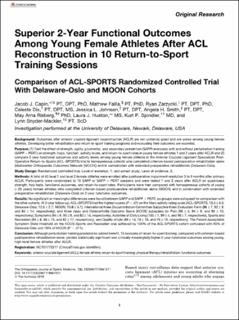| dc.description | This open-access article is published and distributed under the Creative Commons Attribution - NonCommercial - No Derivatives License (http://creativecommons.org/licenses/by-nc-nd/4.0/), which permits the noncommercial use, distribution, and reproduction of the article in any medium, provided the original author and source are credited. You may not alter, transform, or build upon this article without the permission of the Author(s). For article reuse guidelines, please visit SAGE’s website at http://www.sagepub.com/journals-permissions. | en_US |
| dc.description.abstract | Background: Outcomes after anterior cruciate ligament reconstruction (ACLR) are not uniformly good and are worse among young female athletes. Developing better rehabilitation and return-to-sport training programs and evaluating their outcomes are essential. Purpose: (1) Test the effect of strength, agility, plyometric, and secondary prevention (SAPP) exercises with and without perturbation training (SAPP + PERT) on strength, hops, function, activity levels, and return-to-sport rates in young female athletes 1 and 2 years after ACLR and (2) compare 2-year functional outcomes and activity levels among young female athletes in the Anterior Cruciate Ligament Specialized Post-Operative Return-to-Sports (ACL-SPORTS) trial to homogeneous cohorts who completed criterion-based postoperative rehabilitation alone (Multicenter Orthopaedic Outcomes Network [MOON]) and in combination with extended preoperative rehabilitation (Delaware-Oslo). Study Design: Randomized controlled trial, Level of evidence, 1; and cohort study, Level of evidence, 3. Methods: A total of 40 level 1 and level 2 female athletes were enrolled after postoperative impairment resolution 3 to 9 months after primary ACLR. Participants were randomized to 10 SAPP or SAPP + PERT sessions and were tested 1 and 2 years after ACLR on quadriceps strength, hop tests, functional outcomes, and return-to-sport rates. Participants were then compared with homogeneous cohorts of young (<25 years) female athletes who completed criterion-based postoperative rehabilitation alone (MOON) and in combination with extended preoperative rehabilitation (Delaware-Oslo) on 2-year functional outcomes. Results: No significant or meaningful differences were found between SAPP and SAPP + PERT, so groups were collapsed for comparison with the other cohorts. At 2-year follow-up, ACL-SPORTS had the highest scores (P < .01) on the Marx activity rating scale (ACL-SPORTS, 13.5 ± 3.3; Delaware-Oslo, 12.5 ± 2.7; MOON, 10.6 ± 5.1); International Knee Documentation Committee Subjective Knee Evaluation Form (96 ± 7, 92 ± 9, and 84 ± 14, respectively); and Knee injury and Osteoarthritis Outcome Score (KOOS) subscales for Pain (98 ± 4, 94 ± 9, and 90 ± 10, respectively), Symptoms (94 ± 6, 90 ± 9, and 83 ± 14, respectively), Activities of Daily Living (100 ± 1, 99 ± 4, and 96 ± 7, respectively), Sports and Recreation (94 ± 8, 86 ± 15, and 82 ± 17, respectively), and Quality of Life (89 ± 14, 78 ± 18, and 76 ± 19, respectively). The Patient Acceptable Symptom State threshold on the KOOS–Sports and Recreation was achieved by 100% of the ACL-SPORTS cohort compared with 90% of Delaware-Oslo and 78% of MOON (P = .011). Conclusion: Although perturbation training provided no added benefit, 10 sessions of return-to-sport training, compared with criterion-based postoperative rehabilitation alone, yielded statistically significant and clinically meaningfully higher 2-year functional outcomes among young, high-level female athletes after ACLR. | en_US |
